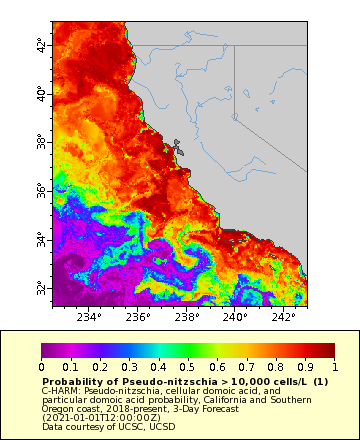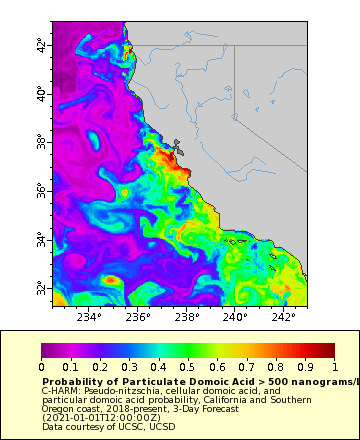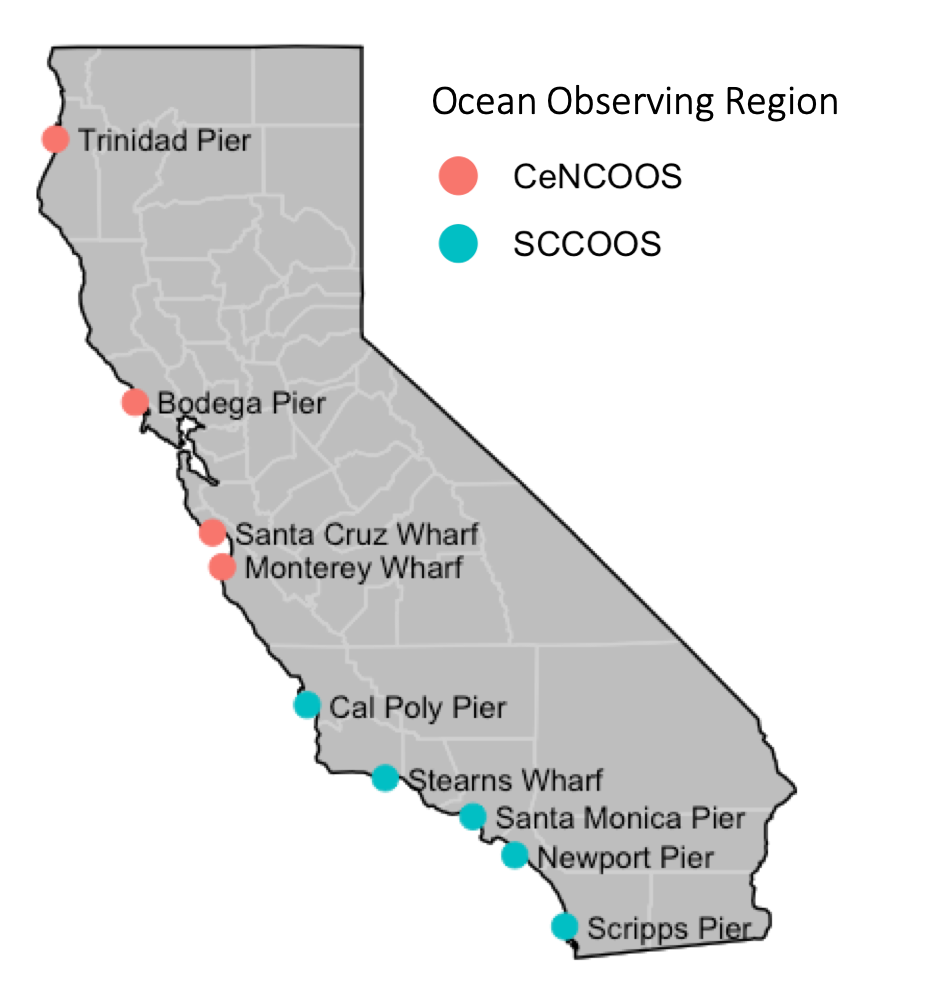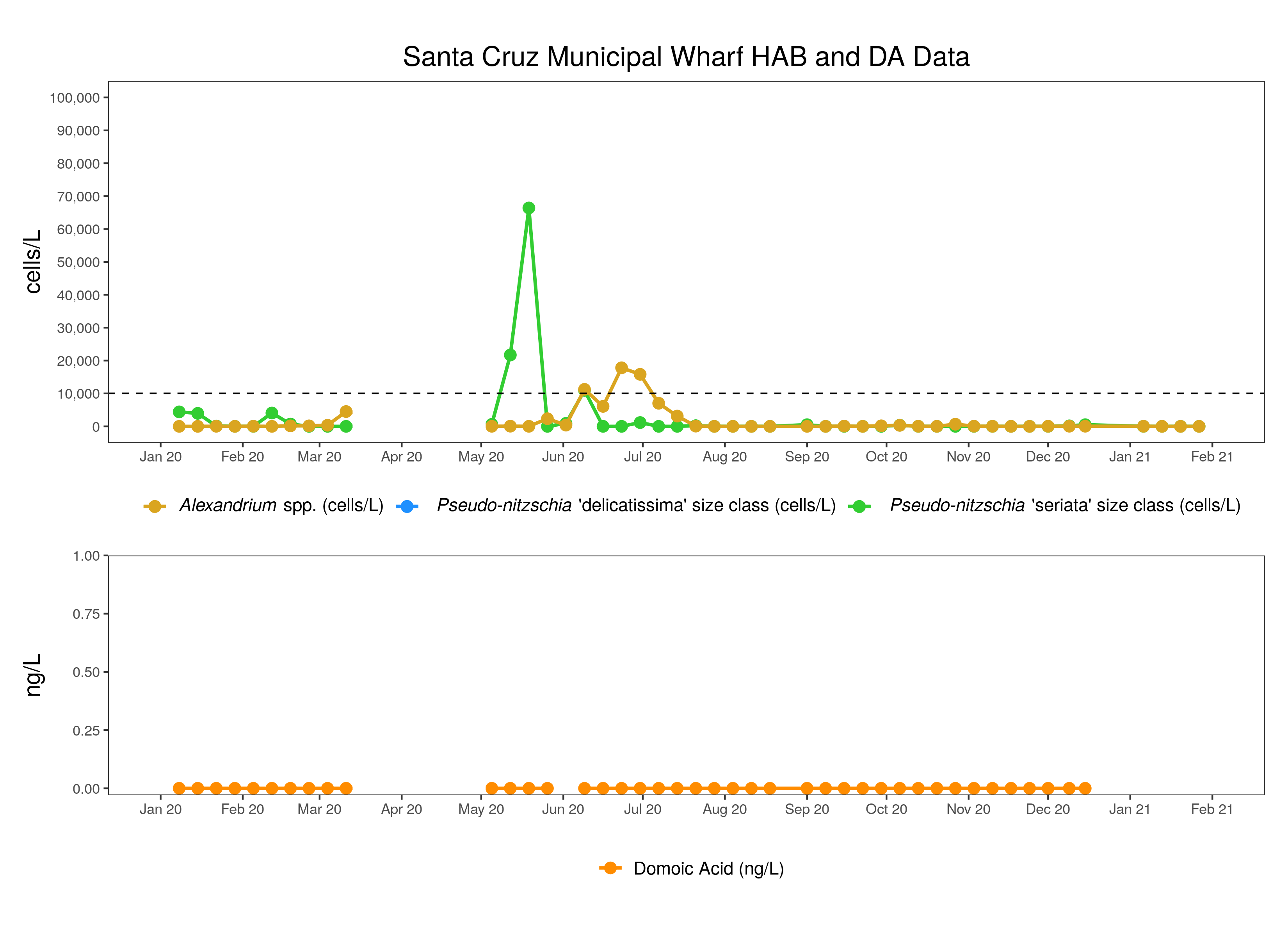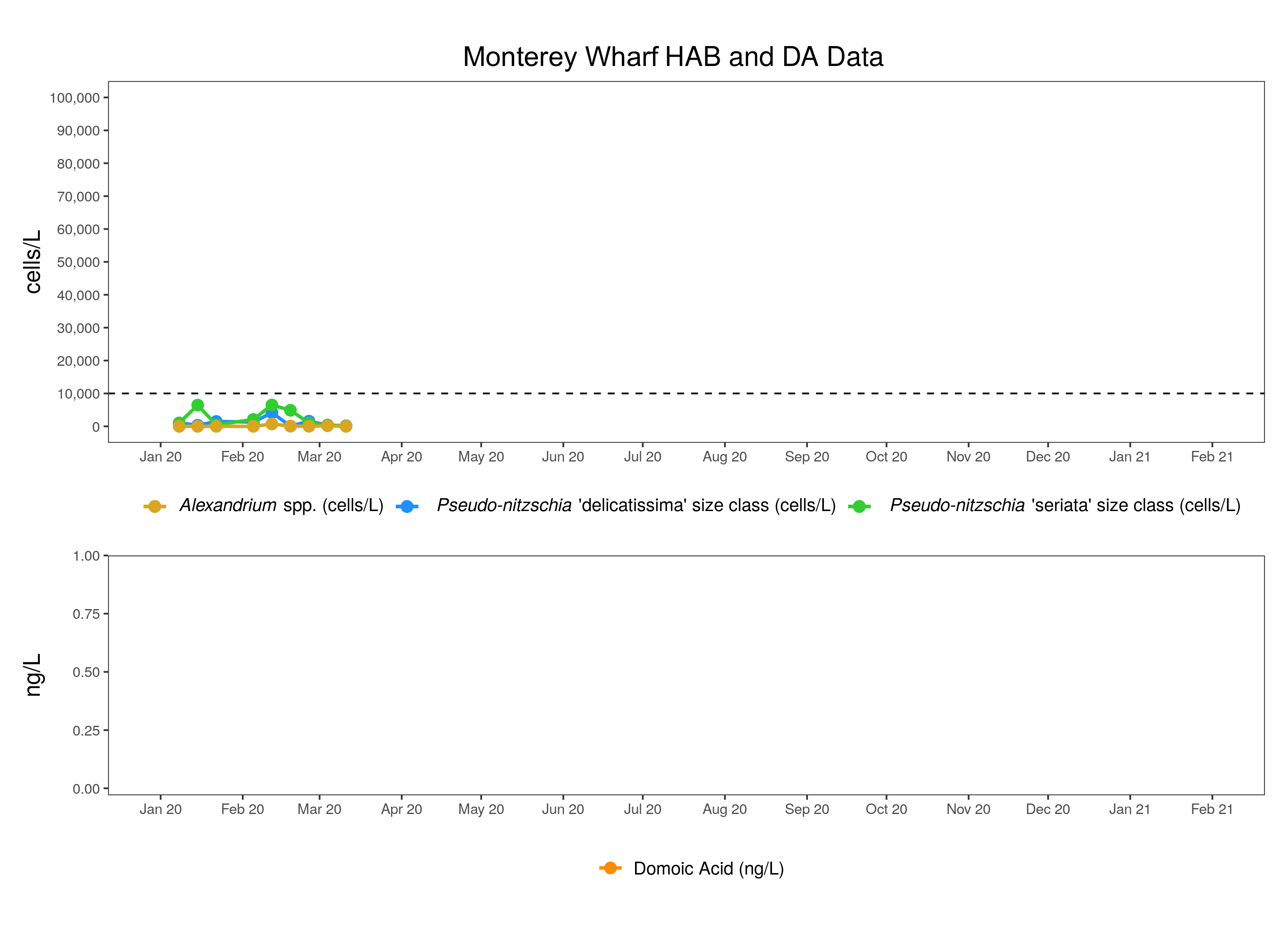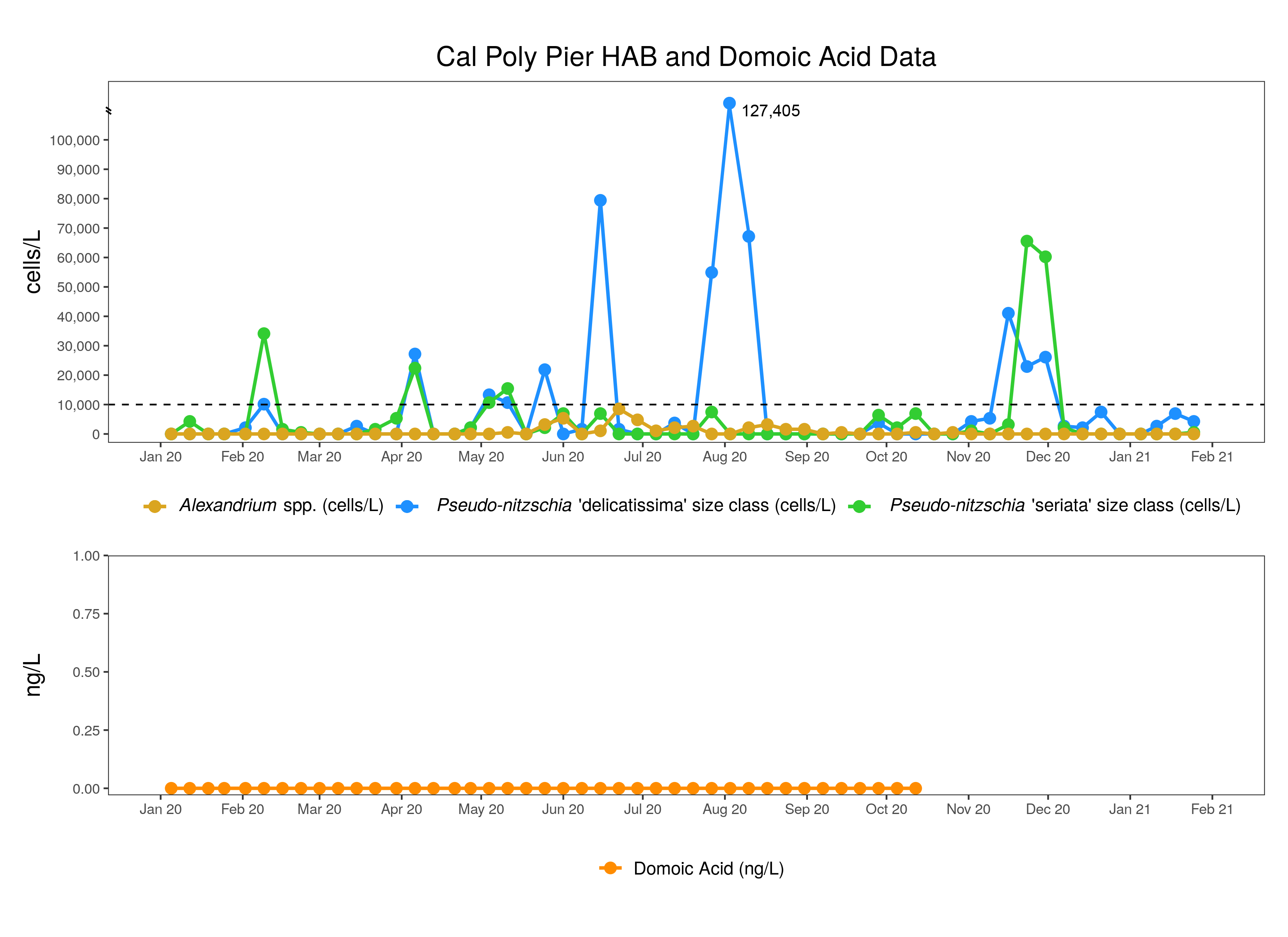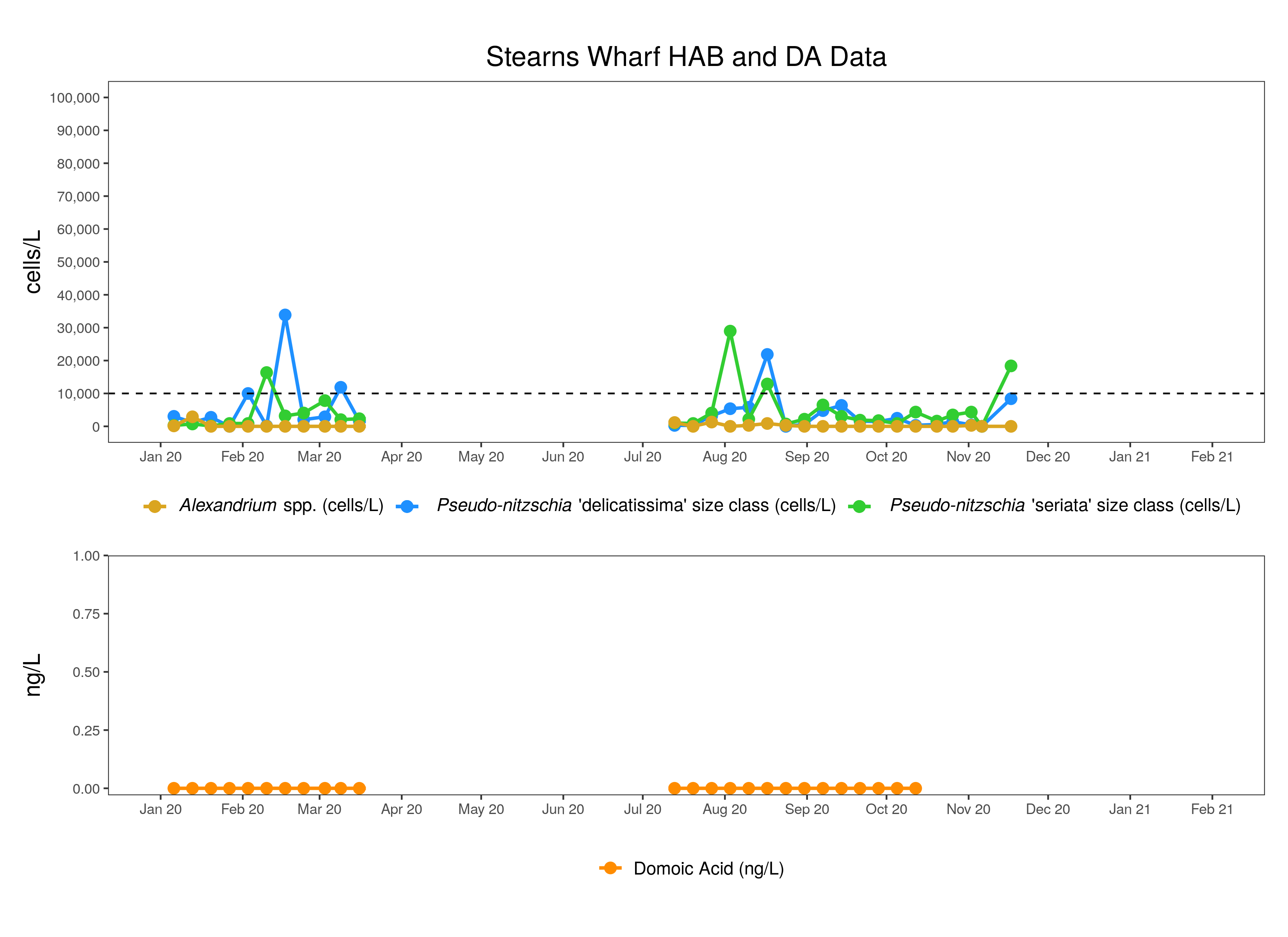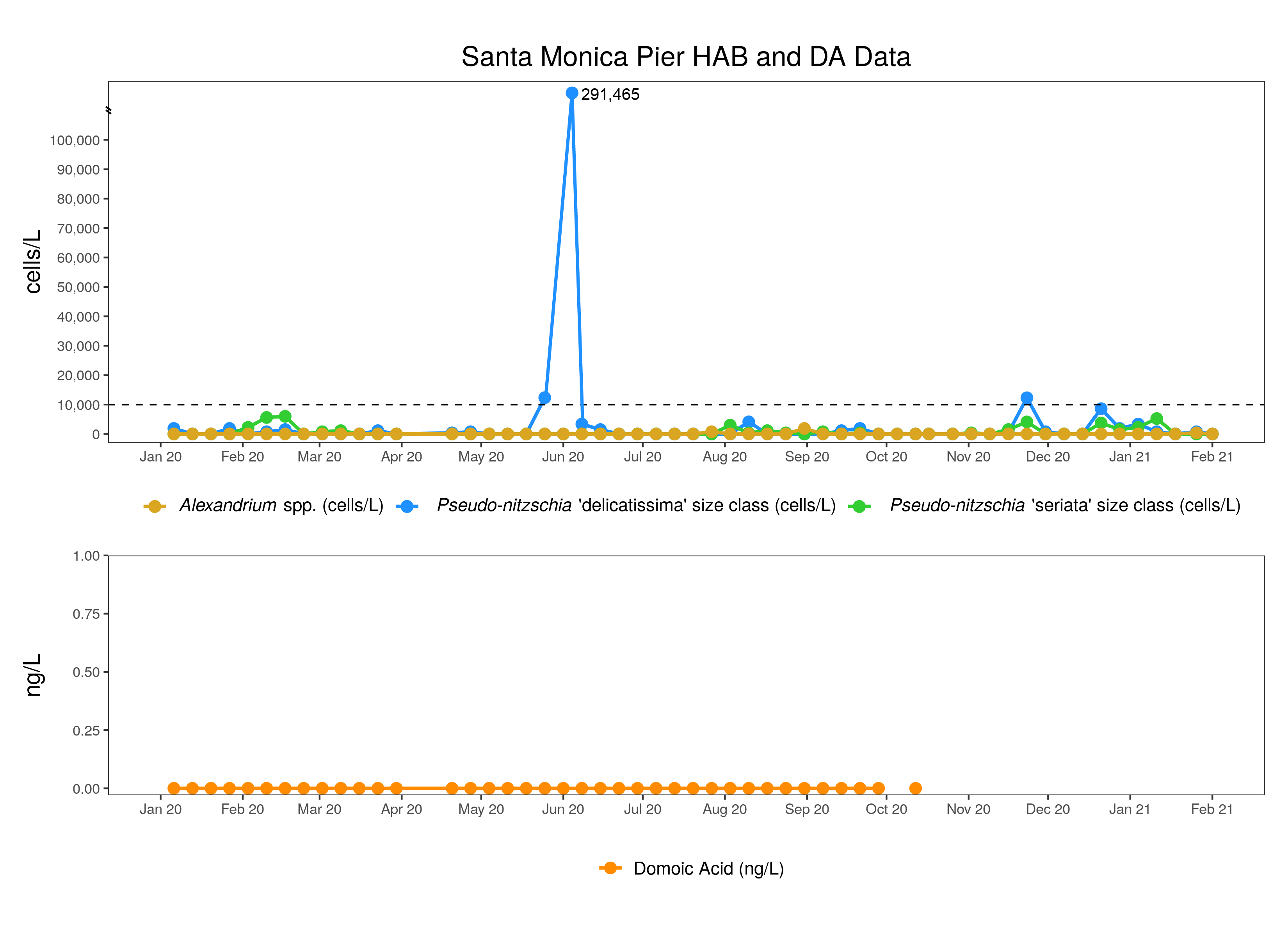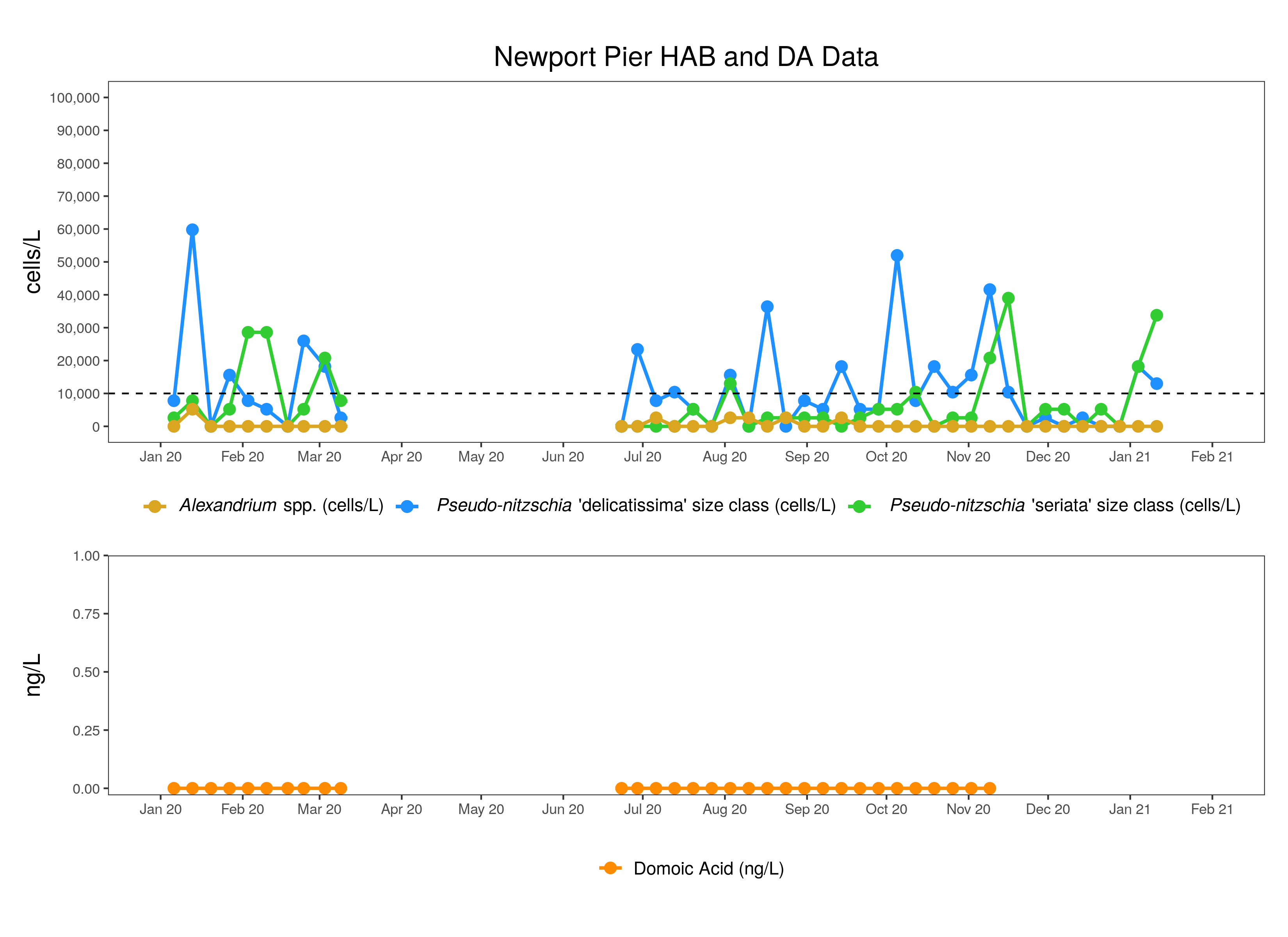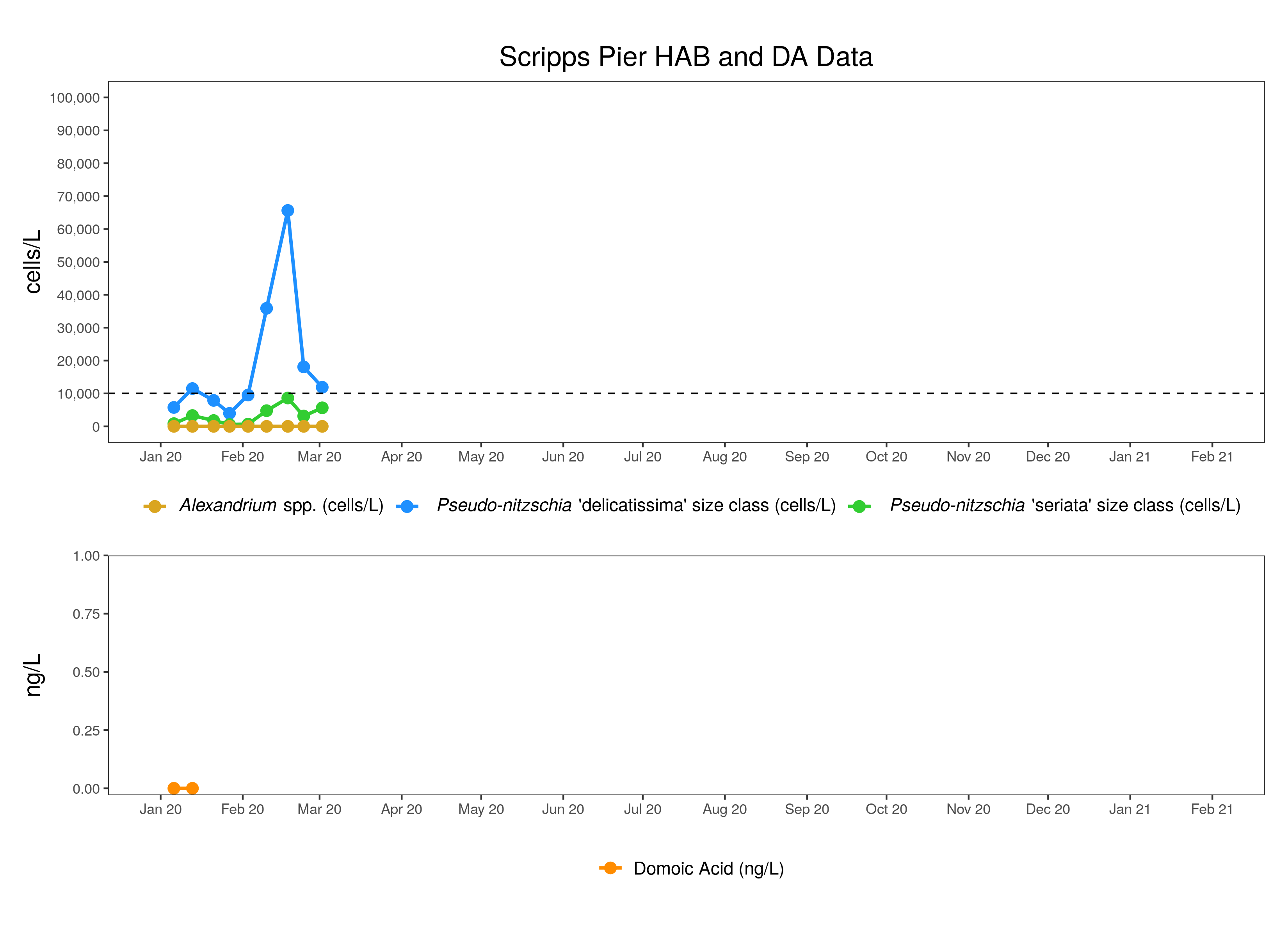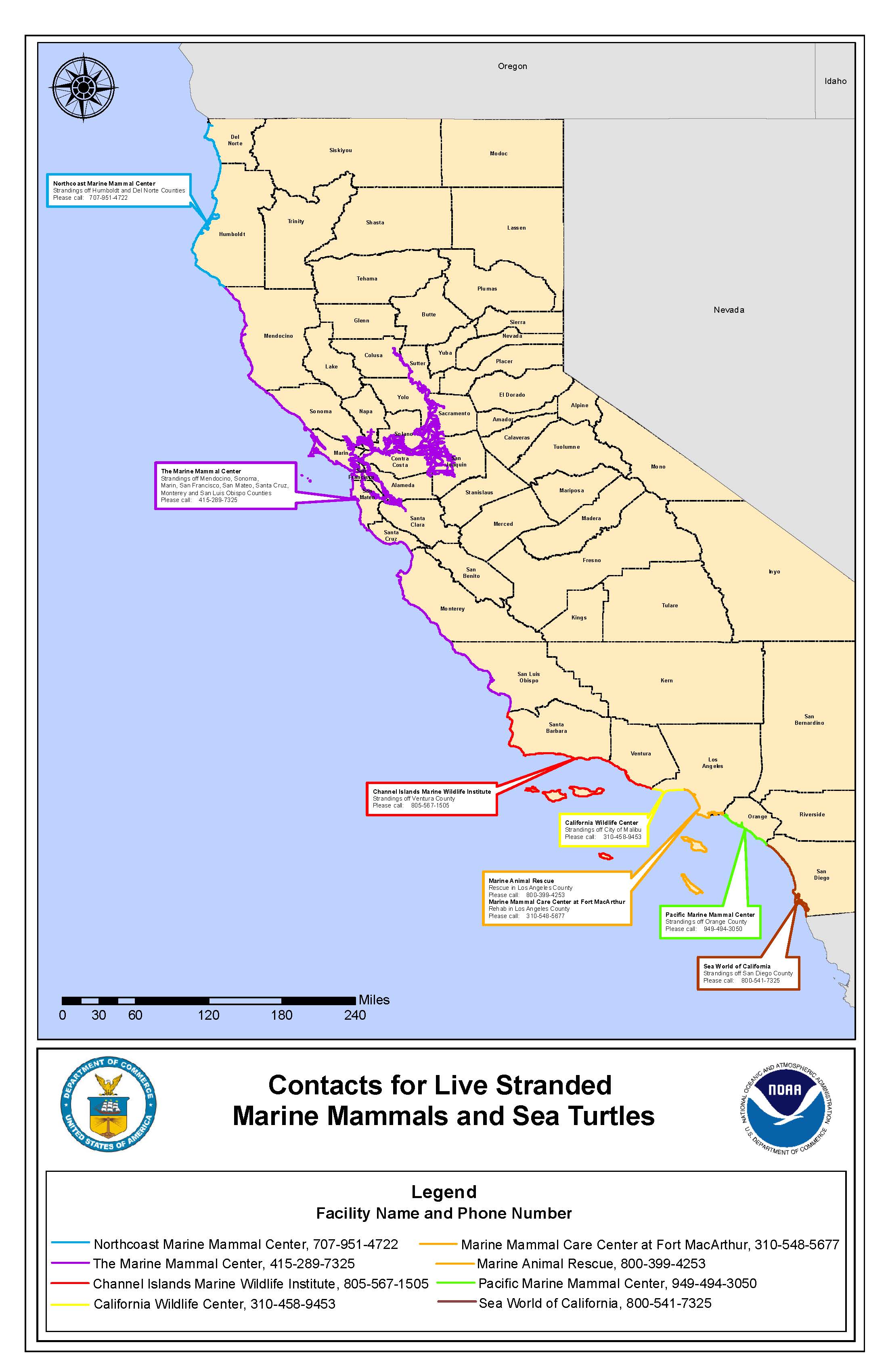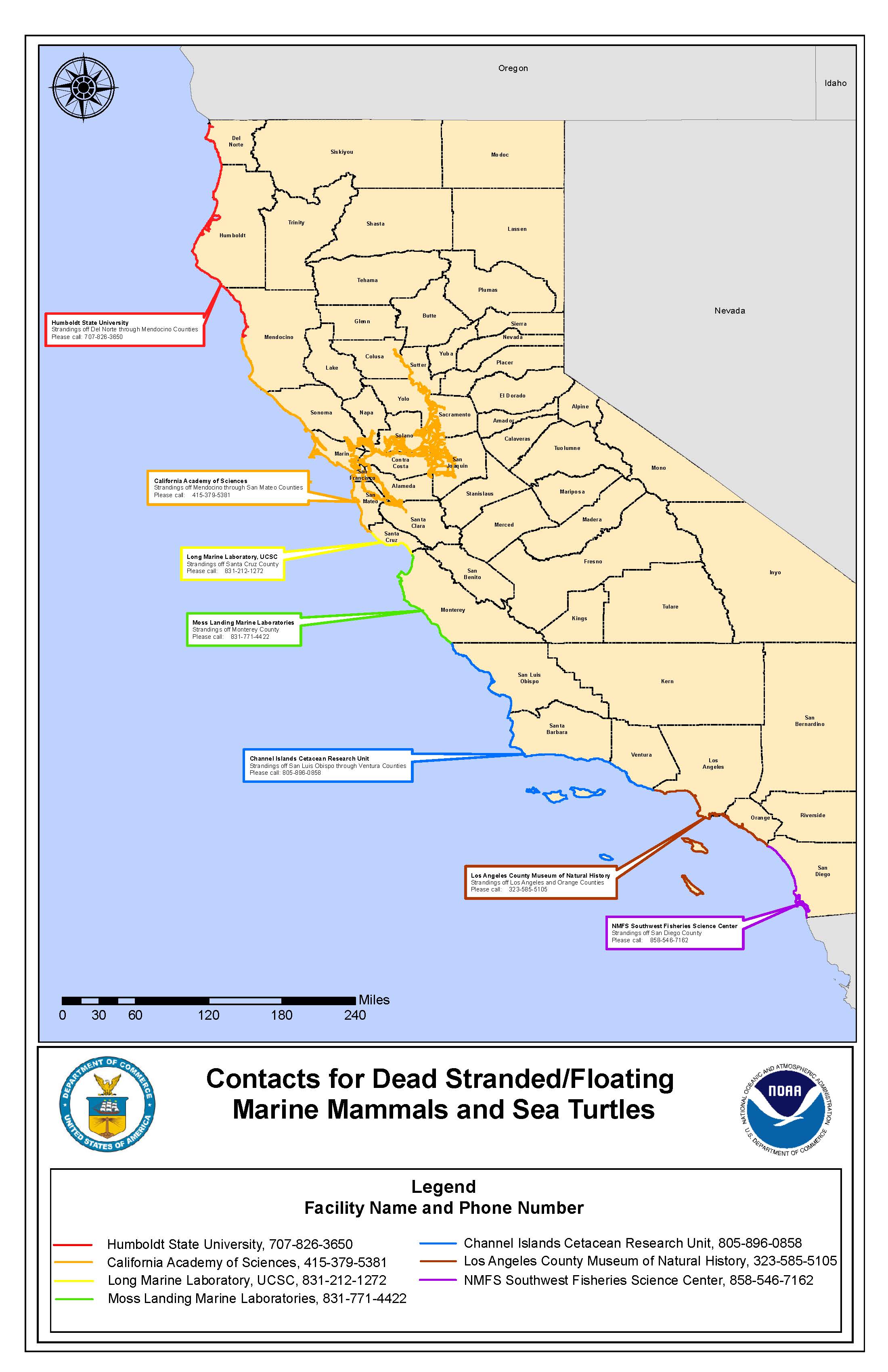Be sure to also read the special Red Tide Bulletin: Spring 2020
Pseudo-nitzschia - C-HARM tells us where conditions are suitable for species of the diatom Pseudo-nitzschia spp. (all size classes) to grow well and where they might be more likely to produce the deadly neurotoxin, domoic acid (DA). The predicted suitable habitat for Pseudo-nitzschia spp. in the first month of 2021 suggested widespread suitability throughout the state for Pseudo-nitzschia to grow and reach bloom levels. In other words, C-HARM is predicting positive habitat suitability for the genus Pseudo-nitzschia in most parts of coastal California much of the time, something that is corroborated by the frequent presence of Pseudo-nitzschia species in water samples at nearshore sites. Given ongoing COVID-19 sampling restrictions and delays that continue to hamper our ability to acquire timely HABMAP observations from piers, not all piers are currently providing data, but we do know that bloom levels for both the toxigenic and nontoxigenic size class of Pseudo-nitzschia were observed only at Newport Beach Pier by the end of January and were just below bloom levels for much of January at Stearns Wharf in Santa Barbara. The relatively nontoxigenic "delicatissima" size class was elevated at Cal Poly Pier in San Luis Obispo but did not reach operational bloom levels. The Relative Abundance Index (RAI) for the Pseudo-nitzschia 'seriata' size class recorded by the CDPH reached moderate ("Common") levels in and around San Francisco and Tomales Bays, signaling a drop in cell abundance from what it was the previous month.
Moderate to very high C-HARM probabilities (50-100%) for particulate domoic acid (pDA) were predicted at different times for several sections of the California coastline in January. Hotspots developed near San Francisco Bay and moved both north and south over the course of the month: Humboldt and Del Norte Counties followed by the Mendocino and Sonoma coastline, central coast and areas surrounding Monterey Bay, the Santa Barbara Channel, San Pedro Bay and much of the Southern California Bight to San Diego. Particulate domoic acid data from HABMAP was not yet available for any site. Similar patterns were predicted for cellular DA (cDA) risk as those for pDA, although often with a greater offshore extent and with higher probabilities in the Southern California Bight areas around Los Angeles and San Diego Counties. The overall take-away the entire fall and winter has been that cDA probabilities were frequently high along the North and Sonoma Coasts (including areas adjacent to SF Bay), suggesting a possible issue there for domoic acid. Recreational shellfish advisories are still in place for Del Norte and Humboldt Counties due to high DA levels in razor clams, while a November safety notification for shellfish harvested in Mendocino County was lifted January 12th. The very high probabilities for pDA (and cDA) in central coast hotspots are consistent with the three California Sea Lion strandings from suspected DA toxicosis in San Luis Obispo and Monterey Counties reported by The Marine Mammal Center (TMMC); no other regions reported suspected DA toxicosis cases in January.
Alexandrium - CDPH observed very low abundances of Alexandrium spp. at sites sampled in January, consistent with HABMAP sampling. However, at the end of December, CDPH issued a PSP advisory for wild-caught shellfish in Marin County after lifting a similar advisory for Humboldt County.
*Please note that HABMAP sampling, CDPH sampling, and marine mammal rescues have been greatly reduced in response to COVID-19 safety measures.
Harmful Algal Bloom Monitoring & Alert Program (HABMAP)
**HABMAP sampling resumed after being suspended in March 2020 in accordance with the Governor's stay at home order. However, COVID-19 safety protocols and sampling restrictions may continue to affect operations and delay results.**
Note that data for some stations are not shown because they are not yet recorded in the public HABMAP archive.
Differentiating Pseudo-nitzschia species by light microscopy is difficult. For this reason, Pseudo-nitzschia "seriata" does not refer to an actual species but rather the larger size class of Pseudo-nitzschia, which is generally a more toxigenic group of species. Alternatively, Pseudo-nitzschia "delicatissima" refers to the smaller size class that is generally non-toxigenic. The dashed line on the plots demarcates the 10,000 cells/L "bloom" threshold designated here for Pseudo-nitzschia populations only.
More information and data visualizations on the statewide HAB network and forecasting system can be found on the California HABMAP website and on the SCCOOS Harmful Algal Bloom page.
Santa Cruz Wharf
Four water samples were collected at Santa Cruz Wharf in January. Molecular probes for toxigenic Pseudo-nitzschia in the "seriata" class are conducted for this site, and was not detected. Alexandrium spp. were detected once (Jan 6) but below the bloom threshold. Domoic acid results are not yet available.
The Santa Cruz Wharf shore station is supported by CeNCOOS PI Raphael Kudela at UCSC.
Monterey Wharf
Water sampling has been suspended at Monterey Wharf since March 2020 in response to COVID-19 safety measures.
Monterey Wharf shore station is supported by CeNCOOS PI's Raphael Kudela at USCS and Jason Smith and Moss Landing Marine Labs.
Cal Poly Pier
Water samples were collected 4 times at Cal Poly Pier in January. Pseudo-nitzschia "delicatissima" was detected three times (Jan 11, 18, 25) and Pseudo-nitzschia "seriata" was detected once (Jan 25). All detections were below the bloom threshold value. Alexandrium spp. were not detected in any samples. Domoic acid results are not yet available.
Cal Poly Pier shore station is supported by SCCOOS PI Ryan Walter and Ally Pasulka at Cal Poly.
Stearns Wharf
No samples were collected at Stearns Wharf in January.
Stearns Wharf is supported by SCCOOS PI Mark Brzezinski and Libe Washburn at UCSB.
Santa Monica Pier
Water samples were collected 4 times at Santa Monica Pier in January. Pseudo-nitzschia "delicatissima" was detected three times (Jan 4, 11, 26), Pseudo-nitzschia "seriata" was detected twice (Jan 4, 11) and Alexandrium spp. were detected once (Jan 26). All detections were below the bloom threshold. Domoic acid results are not yet available.
Santa Monica Pier shore station is supported by SCCOOS PI Rebecca Shipe at UCLA.
Newport Pier
Water samples were collected twice at Newport Beach Pier in January. Pseudo-nitzschia "delicatissima" and Pseudo-nitzschia "seriata" were detected on each occasion (Jan 4, 11) above bloom levels. Alexandrium spp. were not detected and domoic acid results are not yet available.
Newport Beach Pier is supported by SCCOOS PI David Caron at USC.
Scripps Pier
Scripps Pier water samples are not yet available for April through January 2021.
Scripps Pier is supported by SCCOOS and PIs Melissa Carter and Clarissa Anderson at UCSD.
CDPH observations for Pseudo-nitzschia 'seriata' and Alexandrium spp.
Please note, starting in July 2019, CDPH moved to only reporting Pseudo-nitzschia of the seriata complex and not all Pseudo-nitzschia spp. as previously provided.
From 1-31 January 2021, water samples were collected by volunteers and sent to the California Department of Public Health (CDPH) for analysis. Pseudo-nitzschia 'seriata' group was detected in 42 of the 74 samples. Pseudo-nitzschia 'seriata' was detected at "Common" density levels (using CDPH relative abundance index) on 5 occasions: January 3rd (Tomales Bay, 15% composition), 10th (San Francisco, Presidio Pier, 12%), 14th (Drakes Bay, 10%), 15th (Port San Luis, 12%), 31st (Tomales Bay, 10%). Alexandrium spp. were detected in 6 of the 74 samples for the month of January, at "Rare" density or below.
You can view an interactive map and data table of CDPH data from January 2019 to present developed by SCCOOS below or you can also view CDPH Toxic Phytoplankton Observations Map with layers of Pseudo-nitzschia and Alexandrium spp. as well as other phytoplankton species observations (in the pop-up windows).
Data are provided by the California Department of Public Health, Environmental Management Branch.
CDPH and OEHHA Health Advisories
February 8. The California Department of Public Health (CDPH) has lifted the December 31, 2020 shellfish safety notification today related to sport-harvested mussels, scallops, and clams in Marin County.
January 12. The California Department of Public Health (CDPH) has lifted the November 18, 2020 shellfish safety notification today related to sport-harvested mussels, whole scallops, and clams in Mendocino County.
December 31. California Department of Public Health (CDPH) is advising consumers not to eat sports-harvested mussels, clams, or scallops from Marin County due to dangerous levels of paralytic shellfish poisoning (PSP) toxins being detected.
For the latest closures and updates, please visit the CDPH Health Advisories page as a central location of information related to CDPH health advisories. Also available is a map showing the current CDPH Recreational Bivalve Shellfish Advisories (see below).
NEWS: The HAB-related illness workgroup has developed a new webpage for marine HAB-related illness tracking work (https://oehha.ca.gov/fish/general-info/marine-harmful-algal-bloom-hab-related-illness-tracking).
California Marine Mammal and Seabird Strandings from Suspected DA Toxicosis
Domoic acid (DA) is a potent neurotoxin produced by some diatom species of the genus Pseudo-nitzschia. Species exposed to DA can result in seizures, epilepsy, cardiomyopathy, and death depending upon the ingested dose. DA toxicosis commonly occurs in California Sea Lions (Zalophus californianus), presumably due to a combination of foraging behavior and seasonal movements. The Marine Mammal Center (TMMC), Channel Islands Marine Wildlife Institute (CIMWI), California Wildlife Center (CWC), Marine Mammal Care Center Los Angeles (MMCC-LA), Marine Animal Rescue (MAR), the Pacific Marine Mammal Center (PMMC), and SeaWorld act like an emergency room by working to rescue and rehabilitate sick and injured marine mammals, seabirds, and sea turtles.
Among the seven rehabilitation centers we received data for in the month of January 3 marine mammal stranding presented with symptoms of domoic acid toxicosis.
The CIMWI, PMMC, MMCCLA, CWC, and MAR did not record any strandings due to suspected domoic acid in January 2021.
January strandings due to suspected DA toxicosis occurred in the following counties:
- San Luis Obispo (TMMC)
- January 2 - adult, female, California Sea Lion
- January 29 - adult, female, California Sea Lion
- Monterey (TMMC)
- January 21 - juvenile, male, California Sea Lion
At this time we do not have data from the North Coast Marine Mammal Center.
Please subscribe to CA HAB Bulletin listserv to receive the monthly CA HAB Bulletin.

